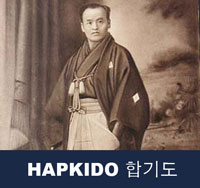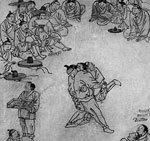Taekwondo 태권도Taekwondo Preschool
Korean martial arts are military practices and methods which have their place in the history of Korea but have been adapted for use by both military and non-military personnel as a method of personal growth or recreation.

Ji Han-Jae 지한재
Ji Han-Jae (Hangul: 지한재; Chi Hon-tsoi) was born in Andong, Gyeongsangbuk-do, South Korea in 1936. He is one of the highest ranking hapkido instructors in the world and founder of Sin Moo Hapkido.
Trainee
He began his martial arts training in 1949 under the direction of Choi Yong-Sool (Hangul: 최용술), and was Dan # 14 under Choi. Ji trained with Choi Yong-Sool until 1956 when he moved to Seoul in order to open a school of self-defence in the nation's capital. Ji Han-Jae trained in the ancient methods of the Korean martial arts, known as Sam Rang Do Tek Gi by a man named Taoist Lee. Though this man's identity can not be confirmed, it is believed that he trained Ji in meditation, the use of the Korean long staff "Jang-Bong (장봉; 長棒)", short staff "Dan-Bong (단봉; 短棒)", and the unique kicks of Sam Rang Do Tek Gi.

Hapkido Master
In 1959 Ji Han-Jae combined all of his martial arts knowledge together and began to teach hapkido. Many people consider Ji Han Jae to be the founder of hapkido, while others will credit his teacher, Choi Yong-Sool, who referred to his art as "Yawara (Hangul: 야와라; 柔)" or "Yu Kwon Sul (Hangul: 유권술; 柔拳術)". It is commonly claimed by his students that it was Ji who first started using the name hapkido for the techniques he was teaching at that time. Seo Bok-Seob, the first student of Choi, however points out in a 1980 interview that it was Jung Moo Kwan who first used the term to refer to the art as well as the symbol of the eagle to represent the art.
Regardless, some of the kicking techniques that many styles of hapkido has today is marked by changes that were implemented by Ji Han-Jae and Kim Moo-Hong (Hangul: 김무홍; also rendered Kim Moo-Woong or Kim Moo-Hyun) who was also a student under Choi Yong-Sool. After studying with Choi, Kim went to a Buddhist temple and learned a local kicking art there. Traveling to Seoul in 1961 he lived and trained with Ji for a period of 8 months and together, implementing the kicking methods they had both learned, they finalized the kicking curriculum for hapkido, significantly expanding it to include kicks to higher targets, spinning kicks and jumping kicks, none of which were originally part of the system taught by Choi Yong-Sool.
In addition to this Ji Han-Jae's original Sung Moo Kwan (Hangul: 성무관) shared space with people who trained in other arts, including Western boxing. Ji and his senior students developed tactics for dealing with techniques of boxing, tang soo do, taekwondo and judo and implemented them into the curriculum.
The great promoter of the art
Leaving Daegu for his hometown of Andong, Ji Han-Jae opened up his first school, the An Moo Kwan (Hangul: 안무관) in 1956, still calling his art Yu Kwon Sool at this time. His earliest students from this period were Kwon Tae-Man (Hangul: 권태만; who teaches in California today), Yoo Young-Woo (Hangul: 유영우), and Oh Se-Lim (Hangul: 오세림; former president of the Korea Hapkido Federation).
After less than a year he decided to relocate to Seoul, the nation's capital, in 1957. There he founded the Sung Moo Kwan (Hangul: 성무관), which would become the an influential kwan, or school of hapkido, producing a great many of the important teachers of the art. His first student was Hwang Deok-Kyoo (Hangul: 황덕규; founder of the Korean Hapkido Association) followed shortly after by Myung Kwang-Sik (Hangul: 명광식; founder of the World Hapkido Federation), Lee Tae-Jun, Kang Jeong-soo. In 1958 students Kim Yong-Jin (Hangul: 김용진), Jeong Won-Seon (Hangul: 정원선; Retired 2007-taught in Rockford, Illinois) Han Bong-soo (of Billy Jack movie fame and founder of the International Hapkido Federation), Choi Sea-Oh (First man to teach hapkido in the U.S.) and Myung Jae-Nam (Hangul: 명재남; Founder of the Korea based International Hapkido Federation and Hankido). It was around this time that Ji began to use the name hapkido to promote the art, shortened from the original "Hap Ki Yu Kwon Sool (Hangul: 합기 유권술; 合氣柔拳術)" name employed at the first school run by Choi Yong-Sool and Seo Bok-Seob in Daegu in 1951.
In 1961, Kim Moo-Hong came to visit Ji and they developed many of the kicking tactics the art is known for.
Organizations
In 1963, Ji Han-Jae was a founding member of the first attempt to create a large organization which would include hapkido. Called the Korean Kido Association (Daehan Kido Hwe; Hangul: 대한 기도회) Choi Yong-Sool was elected the first titular chairperson with the organizations first constitution authored by Ji, Choi and Kwon Jang. Its purpose was to promote martial arts to the public school system, police officers and government officials. Ji was very instrumental in organizing this group however Choi appointed another of his top students, Kim Jeong-Yoon (Hangul: 김정윤), to a position above Master Ji greatly diminishing his influence.
By 1965, Ji had received a position as hapkido instructor for the presidential guard at the Blue House and he thereby became acquainted with Park Jong-Kyoo (Hangul: 박종규), the Head of Security Forces for the country. Unhappy with his lack of input in the Daehan Kido Hwe, with political connections and an ever growing support from his Sung Moo Kwan students he decided to form his own organization the Korea Hapkido Association (Daehan Hapkido Hyub Hwe; Hangul: 대한 합기도 협회). Kim Woo-Joong (Hangul: 김우중), the president of the Daewoo corporation, was elected the KHA's first president.
Later in 1973, seeking to consolidate three of the larger hapkido organizations which had grown up over the years, he united his organization with the Korean Hapkido Association, of his contemporary Kim Moo-Hong, and the Korea Hapki Association, of one of his former senior students, Myung Jae-Nam, to form the large and influential Republic of Korea Hapkido Association (Daehan Min Kuk Hapkido Hyub Hwe; Hangul: 대한민국 합기도 협회).
Politics
Ji Han-Jae's star began to rise quickly when he started teaching hapkido to the president's bodyguards in the South Korean Blue House. In 1979 however, the Korean president, Park Chung Hee was assassinated by Kim Jae-gyu, head of the Korean CIA, and many things changed.
After the assassination of President Park most of those that were close to Park resigned. Included were the presidential bodyguards and the martial arts instructors of the bodyguards. Ji was one of the many that resigned.
In the ensuing struggle for power, many of those that had been in positions of power during the reign of President Park now found themselves without position, power or influence. In many cases those that held positions under President Park were now singled out as targets for legal action, whether justified or not.
In one such case wealthy businessmen had made financial contributions to martial arts organizations, as was the norm. Unfortunately, in several instances the contributions were not properly accounted for. In one case in particular, Ji and his organization were brought up on charges of tax fraud. Even though Ji was generally viewed as not guilty, he was given a prison term of one year. The judge in the case later explained that it was really beyond his control and that if Ji did not go to jail on this minor tax fraud charge, he would no doubt continue to be charged with other offenses until he was sent to prison on something else, perhaps something more serious.
Ji's philosophical view on the matter is that it was worthwhile to experience a year in prison and learn about a side of life very few people experience. He also stated that he was able to further develop the spiritual side of his Sin Moo, 'higher mind', hapkido concept while meditating in the prison environment.
Oh Se-Lim, one of the earliest students of the art under Ji, was elected the new president of the Republic of Korea Hapkido Association. He re-christened the organization the "Daehan Hapkido Hyub Hwe (Hangul: 대한 합기도 협회)", a name used in one of hapkido's former organizations over which Ji presided and Oh had been a founding member. The Korea Hapkido Federation (KHF) became the preferred rendering in English. The Korea Hapkido Federation remains one of the most influential of the many hapkido organizations existing in Korea today. To this day the KHF is still run mostly by students of Ji's original Sung Moo Kwan.
Sin Moo Hapkido Founder
In 1984 Ji Han-Jae moved to the United States and founded Sin Moo Hapkido (Hangul: 신무 합기도). Before he left Korea, Myung Jae-Nam, a close friend of Ji and the head of the International H.K.D Federation, awarded Ji Han-Jae a 10th Dan. The proper title for master Ji now is DoJu Ji. Doju (Hangul: 도주; 道主) implies founder as Ji is the founder of Sin Moo hapkido, if not hapkido itself.
United States
After Ji moved to the United States, he soon managed to gather a large number of students interested in learning hapkido, especially Sin Moo hapkido. Until this day DoJu Ji teaches several seminars a year in North America, Latin America, and Europe.
Films
On his first trip to the United States, Ji appeared in the film Game of Death with Bruce Lee. (Ji did not opt to appear in the additional footage shot for the 1978 version of the film.) Before that he had already made his appearance in a movie called Hapkido (aka Lady Kungfu) together with Angela Mao.
RESOURCES
This article uses material from the Wikipedia article "Ji Han Jae", which is released under the Creative Commons Attribution-Share-Alike License 3.0.



















